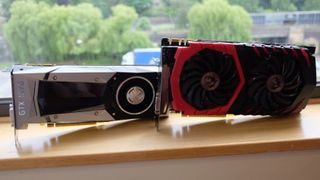Why you can trust TechRadar
The GTX 1070 is, by far, Nvidia's king of 1440p gaming. The 8GB of VRAM (all intact), the Titan X level of performance, the price point. It's all there for high-end, 1440p gaming.
I'm not talking entry point and low average frame rates here, we're on about the upper echelon of those frame barriers; 120Hz plus – the sweet spot – and it certainly doesn't disappoint. Take a quick look at PCMark's Fire Strike Extreme, and you'll notice a 3,200 point deficit between the GTX 970 and this monster, and an even more impressive 2,200 points of difference between the 1070 and last generation's now-nearly-defunct GTX 980.
Benchmarks
Here are the benchmarks we achieved with the MSI GeForce GTX 1070 Gaming X running at stock (test system was an Intel Core i7-6700K, 16GB of HyperX Savage DDR4 @ 2400 MT/s on an MSI Z170A Gaming M7 motherboard, with games tested on highest preset with AA at maximum settings – average frame rates given):

A quick look in Far Cry Primal at 1440p saw the GTX 1070 munch up a monstrous 65 frames per second (fps) on average, as opposed to last generation's GTX 970 attaining a measly 31 fps.
That's with everything ramped up to ultra, AA on max, and with the high-resolution texture packs included. As for your everyday games, and more mainstream titles, 144 fps is nothing short of guaranteed. In World of Warcraft, we enjoyed an impressive 165 fps at 1440p, with all the settings ramped up in a raid environment.
Performance isn't everything
With the launch of Pascal, Nvidia also introduced us to some rather dishy new software components in the form of Ansel and VRWorks Audio. Ansel in short is an in-engine in-game screenshot utility that takes you out of the game as a floating head.
In short, you can pause the game float your camera around until you're in the correct position, adjust the lighting, and up the resolution to take your perfect screenshot. All the way up to 61,440 x 34,560.
That's 1,064 times larger than 1080p – no biggy, right?

On top of that, for those with the fancy VR headsets you can also take full 360 degree screenshots, making this a great way of blagging to your friends how fantastical a system you've got. And then there's VRWorks Audio, a re-imagining of 3D audio primed and ready for the latest generation of VR games going forward.
Cool under pressure
As far as temperatures go on the GTX 1070, you can expect to see that Celsius reading under load hit 81 degrees similar to the GTX 1080, rocking all the way up to 90 if you really let GPU Boost have all the fun. Nothing new here.
With MSI's Gaming X, we saw temperatures stick steady at around 60 degrees under load. And once I tuned in our own overclock (far beyond the factory overclock settings), at most we only ever saw 70 degrees. Pretty impressive, then.
This is all thanks to MSI's new and improved TORX 2.0 fan tech, which, according to the military grade company, ensures that this edition of the Twin Frozr produces 22% more air pressure than it's last generation of GPUs. It's something that really shows, too.
Coupled with that 0dB fan technology we mentioned earlier and using this aftermarket variant, even though it was a little pricier than the Founder's Edition was a solid choice, especially for what you get.

Overclocking experience
Although MSI's GTX 1070 Gaming X does come pre-overclocked, there's always bound to be a little extra leeway when it comes to really getting the most out of your GPU. In this case, we decided to see just how far we could push the GTX 1070's cores.
With my final overclock, we managed to achieve an additional 130MHz on the core clock and 400MHz on the memory, bringing it up nicely to a final boost clock of 2,076MHz, and 8,910MHz on the memory.
Temperatures still remained sub-70 degrees under load in Firestrike, and those final scores increased from 15,440 on the Gaming X's OC setting, to 16,435. Just under 1,000 points – that's 1,500 points more than a stock reference GTX 1070. In game we saw average frame rates increase from 65 fps in Far Cry Primal up to 71 fps. Hey, who can argue with (sort of) free performance?

75% of adults don't know how to recycle electronics — here are the 3 best ways to responsibly dispose of tech

Humane AI Pin review roundup: an undercooked flop that's way ahead of its time

Meta's new AI card is one step to reduce its reliance on Nvidia's GPUs — despite spending billions on H100 and A100, Facebook's parent firm sees a clear path to an RTX-free future
